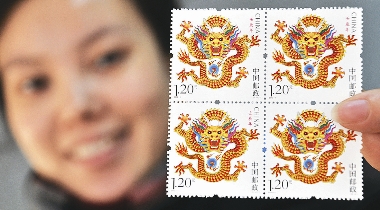
A SET of stamps to mark the Year of Dragon, slated for sales beginning last Thursday, has aroused heated debate on the image of the legendary creature after China Post unveiled the design of the stamp.
“The moment I saw the design of the dragon stamp in newspaper, I was almost scared to death,” Zhang Yihe, a noted writer said in her post on Sina Weibo, China’s Twitter-like social networking service, Tuesday.
“The dragon on the stamp looks too ferocious,” echoed one post on the Web.
“It is roaring and intimidating,” read another.
Few mythological beasts could better arouse a national debate in China than the dragon, because Chinese believe they are descendants of the legendary creature.
The stamp for the Year of Dragon, the third set of its kind issued by China Post since 1949, used a makeup that was close to China’s first stamp in 1878 during the Qing Dynasty (1644-1911) when emperors still ruled the country.
For thousands of years, the Chinese have named each year after an animal in a 12-year cycle. The dragon ranks fifth in the cycle, after the mouse, ox, tiger and rabbit, but before snake, horse, goat, monkey, rooster, dog, and pig. 2012 is the Year of Dragon.
Dragons are traditionally considered to symbolize auspicious powers in China with their control over water, rainfall, hurricanes, and floods. Emperors in ancient China used the dragon as a totem of imperial power.
Chen Shaohua, designer of the new stamp, defended his work, saying the dragon should not be too gentle in image otherwise it would not fit the portraits of dragons in the minds of most Chinese.
“Dragon is the deity of the 12 animals in the Chinese Zodiac, and you can’t modernize the creature like cartoons,” said Chen, who once designed the emblem of Beijing’s bidding for the 2008 Olympic Games.
“Dragons can exorcise evil spirits, avert disasters and bless people. We need a tough image,” Chen said.
Feng Shula, manager of the circulation department of China Post, defended Chen’s design, saying the image of the dragon is exactly what it should look like, based on the references to the dragon robe worn by emperors in ancient China and the Nine-dragon Wall in the Forbidden City in Beijing.
“From this perspective, the new dragon stamp is a perfect combination of history and modernity,” Feng said.
To Zhou Zhihua, president of All-China Philatelic Federation, the discomfort with the 2012 dragon stamp among some people is understandable, given an image that is far different from the prior two sets of dragon stamps.
The first set of dragon stamps issued in 1988 abandoned the awe-inspiring appearance of the legendary creature and used thetraditional Chinese paper-cutting art to soften its appearance. Another dragon stamp issued in 2000 combined the traditional Chinese calligraphy and the dragon pattern of the Qin (221-206 B.C.) and Han (206 B.C.-A.D. 220) dynasties in design and gave a graceful exterior for the dragon.
Despite the controversy, the new dragon stamp is set to bring good fortune to some people in the country.
At Madian, a philatelic market in downtown Beijing, the new set of dragon stamps have been overbooked for prices much higher than its face value of 24 yuan (US$3.8).
“All my subscriptions have been booked and some collectors even asked for one set of the dragon stamps at 180 yuan each,” said Li Wei, a stamp and coins seller at the market.
“I hope the thriving can bode well for the full year this year,” he said.
(Xinhua)
Smallest Chinese ethnic group releases first music album in minority dialect
FOR the first time ever, the De’ang people, one of China’s smallest ethnic minorities, have a folk music album in their own language.
The Yunnan Audio and Video Publishing House has just released an album of De’ang folk songs, which is not only the first De’ang music album but also the first ever publication in the De’ang language, an official with the provincial press and publication bureau said Friday.
The eight-song record, funded by a special government fund to protect the languages of ethnic minorities, will help keep the rich cultural heritage of the De’ang alive and make sure it can be passed on to future generations, said the official.
Dubbed “tea growers,” the De’ang ethnicity has only about 20,000 people who live in the southwestern province of Yunnan. They have their own spoken language, but use Han characters for writing.
The De’ang are among the oldest peoples living in the southwestern border area. They settled west of the Nujiang River as early as 200 B.C.
Women of this ethnic minority keep their hair short and wrap their heads in black turbans. They wear heavy earrings, silver necklaces and long skirts. Men, who are fond of tattoos, wear black or white turbans, large earrings and silver necklaces. (Xinhua)
|

